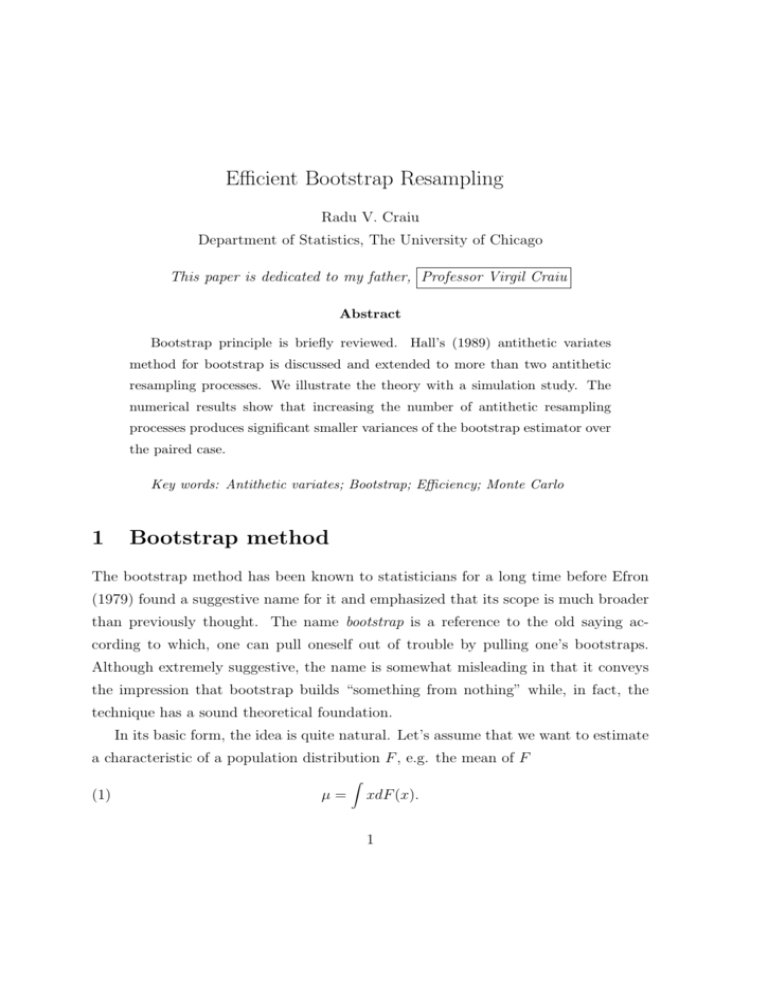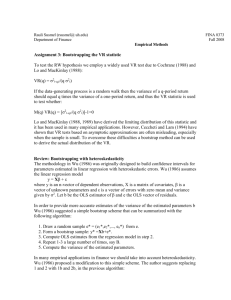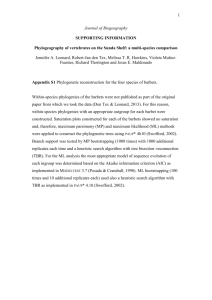Efficient Bootstrap Resampling 1 Bootstrap method
advertisement

Efficient Bootstrap Resampling
Radu V. Craiu
Department of Statistics, The University of Chicago
This paper is dedicated to my father, Professor Virgil Craiu
Abstract
Bootstrap principle is briefly reviewed. Hall’s (1989) antithetic variates
method for bootstrap is discussed and extended to more than two antithetic
resampling processes. We illustrate the theory with a simulation study. The
numerical results show that increasing the number of antithetic resampling
processes produces significant smaller variances of the bootstrap estimator over
the paired case.
Key words: Antithetic variates; Bootstrap; Efficiency; Monte Carlo
1
Bootstrap method
The bootstrap method has been known to statisticians for a long time before Efron
(1979) found a suggestive name for it and emphasized that its scope is much broader
than previously thought. The name bootstrap is a reference to the old saying according to which, one can pull oneself out of trouble by pulling one’s bootstraps.
Although extremely suggestive, the name is somewhat misleading in that it conveys
the impression that bootstrap builds “something from nothing” while, in fact, the
technique has a sound theoretical foundation.
In its basic form, the idea is quite natural. Let’s assume that we want to estimate
a characteristic of a population distribution F , e.g. the mean of F
(1)
µ=
Z
xdF (x).
1
If we dispose of a sample of size n from F , x = {x1 , . . . , xn } it is natural to replace
F in equation (1) with its closest available discrete counterpart, F̂ , the empirical
distribution function associated to the sample x, and estimate µ with
(2)
X̄ =
Z
xdF̂ (x).
It is worth emphasizing that the above approach is not practicable for all functionals. Moreover, in most applications the bootstrap statistics are hard to compute.
Efron showed that a way around this difficulty is the use of Monte Carlo methods,
specifically, “bootstrap resampling”. In what follows, a resample will be, given the
sample x, an unordered collection of n items x∗ = {x∗1 , . . . , x∗n } sampled with replacement from x. We will denote by F ∗ the empirical distribution function of x∗ .
In most cases where statistical inference is needed, we try to find a way to describe
the relationship that exists between a sample and the population from which the
sample has been drawn. Hall (1992) formally states the problem as follows: given a
class of functionals {ft : t ∈ T } we need to find t0 such that ft0 is the solution of the
equation
(3)
E[ft (F, F̂ )|F ] = 0.
For example, if
µr =
Z
r
xdF (x)
is the r-th power of the population distribution mean, then the sample estimate will
be
µ̂r =
Z
r
xdF̂ (x)
To correct for bias one would like to find t0 the solution of
E[ft (F, F̂ )|F ] = E[µr − µ̂r + t|F ] = 0.
Our bias corrected estimate for µr will be then µ̂r + t0 .
To obtain an approximate solution to equation (3) we will apply our assumption
that the relationship between F and F̂ is well approximated by the relationship
2
existent between F̂ and F ∗ . An approximate solution to (3) will then be the solution
to
(4)
E[ft (F̂ , F ∗ )|F̂ ] = 0
In most cases the conditional expectation in (4) is approximated using samples from
a distribution determined by the original sample x.
We would like to emphasize that the bootstrap method is not needed in all circumstances. The underlying idea is that of replacing the true distribution function
F with F̂ and F̂ with F ∗ in a formula that expresses a parameter as a functional of
F . For applications where the substitutions are unlikely to produce estimates similar
to the originals, the method will produce unreliable results.
2
Antithetic variates
The word antithetic refers to the main objective of the method, that is, to produce
random numbers that are negatively correlated. The reason for which statisticians
are interested in such negatively correlated numbers is emphasized by the following
simple example. Consider the problem of estimating the integral
ξ=
Z
b
h(x)dx
a
by Monte Carlo. The standard crude Monte Carlo estimator uses a sample drawn
uniformly on (a, b), x1 , ..., xn and approximates ξ with (b − a)
Pn
i=1
h(xi )/n. The
antithetic principle (Hammersley and Morton, 1956) states that the above estimate
will be subject to less variability if, for each xi , we also use its “mirror” xi ‘ = a + (b −
xi ). This mirror variate is called an antithetic variate and its use can be effective in
reducing the variance of the Monte Carlo estimate. For a sample of size n, one can
combine the sampled points and their mirrored counterparts into
n
b−aX
(h(xi ) + h(xi ‘)).
n i=1
3
The key ingredient of the method is the negative correlation induced between h(X)
and h(X 0 ). It is natural then to suppose that the use of antithetic variates is related
to a certain monotonicity structure existent in the problem (in the above simple
example, h should be monotone on (a, b) for the variance reduction to surely take
place).
It is known that the Fréchet-Hoeffding inequality’s lower bound (Fréchet, 1951) for
two-dimensional distribution functions is a distribution function itself (e.g. Joe, 1998).
This makes (U, 1 − U ), where U ∼ U (0, 1), the best choice for a pair of antithetic
variates (see also Whitt, 1976). Unfortunately, for a number of random variates larger
than two, the lower bound is no longer a distribution function and an uniformly
best solution to the problem is unknown. Craiu and Meng (2001) are proposing a
few methods to generate K antithetic variates and discuss ways to implement the
antithetic principle in approximate and exact Markov chain Monte Carlo (MCMC).
For good introductory references to exact MCMC algorithms see Casella, Lavine, and
Robert (1999) and Wilson (2000). In the next section we will discuss the antithetic
principle for bootstrap as presented by Hall (1989) and we will perform a numerical
experiment that will show that the increase in the number of antithetic processes
results in significant efficiency gains. We will take a different approach then the
one recommended for MCMC algorithms since, for bootstrap, the method aims at
antithetically sampling from discrete distributions with a finite support.
3
Antithetic resampling for the bootstrap
In the present section we present an antithetic variates method for conducting bootstrap resampling operations. We will follow in the tracks of Hall (1989) but we will
also extend his method to more than two parallel resampling operations at a time.
Suppose we are interested in the expected value µ of an order-invariant statistic
4
θ(X1 , . . . , Xn ). The bootstrap estimate of this quantity is
µ̂ = E[θ(X1∗ , . . . , Xn∗ )|X]
where X = {X1 , . . . , Xn } is the random sample and {X1∗ , . . . , Xn∗ } are drawn with
replacement from X. In practice, we approximate µ̂ with
µ̂∗ =
(5)
B
1 X
∗
∗
θ(Xb1
, . . . , Xbn
)
B b=1
where, conditional on X, Xbi∗ are independently and uniformly distributed on X.
The samples Xi are d-dimensional, with d ≥ 1. Another way of writing (5) is
µ̂∗ =
B
1 X
∗
∗
θ(XI(b,1)
, . . . , XI(b,n)
)
B b=1
where I(b, i) are independently and uniformly distributed on the integers 1, . . . , n.
Antithetic resampling is based on antithetic permutations π1 , . . . , πk of the integers
1, . . . , n. If the π’s are chosen appropriately and
µ∗j
B
1 X
=
θ(Xπ∗j (I(b,1)) , . . . , Xπ∗j (I(b,n)) ),
B b=1
then µ∗j , j = 1, . . . , k should be negatively correlated conditional on X.
To appreciate the form the antithetic permutations should take we will assume
that θ(x1 , . . . , xn ) is actually a function of the mean
θ( n1
Pn
1
n
Pn
i=1
xi . We will write θ(x1 , . . . , xn ) =
xi ).
i=1
Assume that the vectors Xi are d-variate and θ is smooth and define θi (x) =
∂
θ(x)
∂xi
and
Yh =
d
X
θi (X̄)(Xh − X̄)i
i=1
where the superscript i on a vector denotes the i-th element of that vector and
X̄ =
1
n
P
i
Xi
We relabel the sample values Xi so that Y1 ≤ Y2 ≤ . . . ≤ Yn .
5
By Taylor expansion we have
µ̂∗j
=B
−1
B
X
∗
θ(X̄b,π
)
j
= θ(X̄) + B
where
=
1
n
Pn
i=1
B X
d
X
∗
θi (X̄)(X̄b,π
− X̄)i + . . .
j
b=1 i=1
b=1
∗
X̄b,π
j
−1
Xπj (I(b,i)) .
Following Hall (1989) we have that
V ar(µ̂∗j ) = (Bn)−1 n−1
n
X
Yi2
i=1
and if g 6= h
cov(µ̂∗h , µ̂∗g ) = (Bn)−1 cov(Yπh (I(b,n)) , Yπg (I(b,n)) |s) = (Bn)−1 n−1
n
X
Yπh (i) Yπg (i)
i=1
where all errors of approximation are O(B −1 n−2 ).
Therefore, if we want to use k antithetic resampling processes , we need to find
k − 1 permutations π2 , ..., πk such that for any Y1 ≤ Y2 . . . ≤ Yn we have, for π1 the
identical permutation
n
XX
(6)
Yπg (i) Yπh (i) = minimum possible
g6=h i=1
If k = 2 an uniform optimal solution is π1 (i) = i and π2 (i) = n − i + 1 for all 1 ≤
i ≤ n. The solution is uniform optimal in the sense that for any Y1 ≤ Y2 ≤ . . . ≤ Yn
the sum
P
j
Yj Yπ1 (j) is minimal.
For k ≥ 2 such an optimal solution doesn’t exist. For instance, if k = 3, for
each arbitrarily fixed sequence Y1 ≤ Y2 ≤ . . . ≤ Yn one can find π1 , π2 , π3 such that
n
P
j=1
(Yπ1 (j) Yπ2 (j) + Yπ2 (j) Yπ3 (k) + Yπ1 (j) Yπ3 (k) ) is minimum possible, but the permutations
may change as a new sequence is drawn. Although an algorithm to determine π1 , π2 ,
and π3 for each sequence of Y ’s can be constructed, such an endeavor is expensive in
terms of computing effort. Instead, we propose a way to combine variance reduction
improvement and reduced additional computer effort by devising an algorithm that
remains unchanged once k is fixed.
6
One can show that if we think of the solution as unique (although it isn’t!) then
the optimal solution is such that π1 (i) = i and π2 , π3 have to be permutations obtained
as products of 3–cycles. We will use in our algorithm this information although we
know it is not the optimal choice for any vector of Y ’s. We choose the entries for
each cycle such that they are situated “symmetrically” away from the extremities of
the sequence Y1 ≤ Y2 ≤ ... ≤ Yn . Of course, since we are dealing with cycles of odd
length, the term “symmetric” is loosely used here. The 3–cycles we choose to use
are among those that minimize the sum of the form (6) for n = 3 and when the Y ’s
are equidistant: (I): (1 3 2), and (II): (1 2 3). The way we mimic the “grouping
of the extremes” that takes place in the case k = 2 is, for k = 3, to include in the
3-cycles numbers that are at the opposite ends of the sequence Y1 ≤ Y2 ≤ ... ≤ Yn .
Specifically, the first cycle will contain {1, n, n − 1}, the second, {2, 3, n − 2} and so
on until there are less than three entries from {1, 2, . . . , n} that are not included in
one of the cycles. Those elements, if any, will be left unchanged (if there is only one
left) or will be transposed by one of the permutations. As a result, we define π2 as
the product of cycles of the type (I), and π3 as the product of cycles of the type (II)
and each the first 3–cycle from π2 and , respectively, π3 , will contain the same entries.
For example, if n = 7 , π2 and π3 will be
π2 =
1 2 3 4 5 6 7
7 5 2 4 3 1 6
1 2 3 4 5 6 7
and
π3 =
6 3 5 4 2 7 1
.
Although the scheme is not uniformly optimal, simulations show that important
variance reductions take place when we use π1 , π2 , and π3 to increase the number
of antithetic resampling processes to k = 3. We emphasize that one can write a
subroutine which generates π2 , π3 automatically once n is given since the construction
depends only on n mod 3.
7
In the following table we summarize the variance reductions obtained when we
compute bootstrap estimates of a mean E[X] + E[Y ] based on a i.i.d. sample of size
50 from (X ∼ N (3, σ 2 ), Y ∼ Gamma(1, 1)). Following the recommendations given in
Efron and Tibshirani (1994) we used 210 bootstrap resamples and we estimated the
variance reduction using a Monte Carlo sample of size 5000. The entry in a given cell
represents the ratio between the Monte Carlo estimate of the bootstrap estimator’s
variance when using k antithetic processes and the same variance computed with
independent bootstrap resamples. We would like to stress that the technique is applicable to other problems, like estimation of cumulative distribution functions (see
also Hall, 1989 for more illustrations).
k\σ
1
2
3
4
6
8
10
20
2
0.89 0.90 0.78 0.65 0.65 0.68 0.71 0.68
3
0.71 0.39 0.38 0.32 0.33 0.32 0.36 0.27
Table 1: Variance reduction ratio V aranti /V arindep for different values of σ and k
antithetic resampling processes
It is striking that when σ is large and compensates for the skewness in the Gamma
distribution, the paired antithetic variates are doing well but by using k = 3 we shrink
the variance reduction ratio by more than 50% relative to the k = 2 case. Moreover,
while for k = 2 the variance reduction is smaller as the population variance gets
smaller, the pattern doesn’t appear as obvious in the k = 3 case. We are left with
the impression that the increase in efficiency is more robust when a higher number of
processes are run in parallel. More theoretical work needs to be done to explain this
pattern.
Therefore, if we were to leave the reader with a single message, this would contain the advice that whenever the antithetic principle is recommended, one should
8
implement it with more than two antithetically paired processes.
Acknowledgments
The author thanks Professor Xiao-Li Meng for encouragement and helpful discussions.
References
[1] George Casella, Michael Lavine and Christian Robert. Explaining the Perfect
Sampler. Technical Report, ISDS, Duke University, Durham, 2000.
[2] Radu V. Craiu and Xiao-Li Meng. Multi-process parallel antithetic coupling for
forward and backward Markov chain Monte Carlo. Technical Report, Department
of Statistics, The University of Chicago, 2001.
[3] Radu V. Craiu. Multivalent Framework for Approximate and Exact Sampling
and Resampling. Doctoral Dissertation, Department of Statistics, The University
of Chicago, 2001.
[4] Bradley Efron and Rob Tibshirani. An Introduction to the Bootstrap, Chapman
and Hall, New York, 1994.
[5] Maurice Fréchet. Sur les tableaux de corrélation dont les marges sont données.
(French) Ann. Univ. Lyon. Sect. A. 14: 53–77, 1951.
[6] Peter Hall. Antithetic resampling for the bootstrap. Biometrika, 76:713–724,
1989.
[7] Peter Hall. The Bootstrap and Edgeworth Expansion. Springer, New York, 1992.
[8] D. C. Hammersley and K. V. Morton. A new Monte Carlo technique: antithetic
variates. Proc. Camb. phil. Soc., 52:449-475, 1956.
9
[9] Harry Joe. Multivariate Models and Dependence Concepts. Chapman and Hall,
New York, 1997.
[10] Wei-Liem Loh. On Latin hypercube sampling. Ann. Stat., 24:2058–2080, 1996.
[11] M. D. McKay, R. J. Beckman, and W. J. Conover. A comparison of three methods
for selecting values of input variables in the analysis of output from a computer
code. Technometrics, 21:239–245, 1979.
[12] David B. Wilson. Layered multishift coupling for use in perfect sampling algorithms (with a primer on CFTP). In Neil Madras, editor, Monte Carlo Methods
- Fields Institute Communications vol. 26, 141–176, 2000.
[13] Ward Whitt. Bivariate distributions with given marginals. Ann. Statist., 4:1280–
1289, 1976.
10







